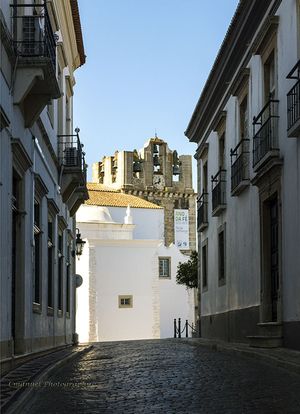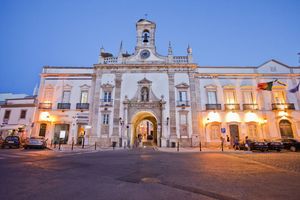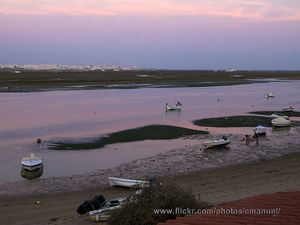
Faro, Portugal
Discover what to see in the city of Faro, Algarve, Portugal.
The city of Faro, capital of Algarve, is detached from the Atlantic Ocean by a lagoon. This phenomena prevents its beaches from being invaded by "sun and sea" tourists, who seem to look for closer beaches.
Faro is a welcoming and quiet town, featuring an entertaining sport centre, parks, and well-maintained squares, as well as a historic centre (Vila-Adentro) full of pedestrian streets and coffees with charming terraces. The students’ population always implies a lively nightlife; whereas the medieval areas, excellently maintained, house many interesting museums, churches, and an interesting bone-chapel.
If you are looking to discover the historic centre by foot, there are two recommended tours. One in the historic centre, known as Vila Adentro, which is short but intense. After crossing the Arco da Vila, with its Italian-style pilasters and a niche containing a statue of Santo Tomás de Aquino (Thomas Aquinas), you walk up Rua do Município until arriving at the street of the Sé, presided by a statue of franciscan bishop Gomes do Avelar, where the monumental Sé or Cathedral of Faro stands, with a mixture of architectonic styles.
The remaining of the square is limited by the Paço Episcopal (18th century), featuring one of Portugal’s most important tile panels at the entrance; the Seminário Diocesano, and the Câmara Municipal. At the end of a narrow alley appears a tiny door opened in the city walls towards the lagoon.
After having visited the Cathedral, you could walk along Rua Domingos Guielro which will lead you to Praça de Alfonso III. This square features a bronze statue of the kind and the Nossa Senhora a Assunção convent (16th century). The convent is renaissance in style and considered by many experts as one of the most important buildings in Faro. The convent is now house to the Faro City Museum, where you can attend archaeological exhibitions spanning from the Paleolithic to the Medieval period, as well as fabrics, weapons, and much more!
Once you have taken a look to these places, why not crossing the Arco do Repouso, an Arab gate opened to the end of the city walls? The spot is commonly known as Resting Arch since it was here where D. Alfonso IV marched to rest and listen to music after having taken the city. The gate will take you directly to the Largo de São Francisco, where stands a convent which church (XVII-XIX century) houses a rich collection of tiles.
Opposite to São Francisco, the old electricity factory has been repurposed to house the Centro de Ciencia Viva do Algarve (Science Centre).
The other walking tour surround the neighborhoods within the 17th century walls. It starts just in front of the Igreja da Misericórdia church, in the very Praça Francisco Gomes, a large square decorated with palm trees.
On the western side of the square lies the Almirante Ramalho Ortigão Maritime Museum, with a charming collection of boats, sea tacks, Medieval scenes, and sea life. In the centre of the square you will see a kind of road for small boats known as Doca. The northern side accessed La Baixa, the main commercial area of Faro. La Baixa is composed of small streets cramped with craft shops, clothing, gifts, and the Regional Ethnographic Museum, focused on regional ethnography with collections of photographs, paintings, and typical objects.
If you prefer to roam the city freely, you shouldn’t miss the Igreja do Carmo church, an 18th century Franciscan church, and the macabre Capela dos Osos Bone Chapel, decorated with the bones and skulls from monks buried in a nearby cemetery. Other spots you must-see are the Igreja de São Pedro Church (16th century), the Lethes Theatre, and the Ermida da Esperança shrine.
As for the newer area of the city, it’s worth seeing the Praça da Liberdade Square and follow the Avenida 5 de Octubro to reach the Ermida de Santo António do Alto shrine lookout. In here, the Jewish cemetery, the Quinta da Horta do Ourives (XVII century), and the Casa das Figuras are important things to check out.
On its vicinity, why not checking out the lagoons of the Ría Formosa Natural Park and its beaches? Among them, the urban Praia do Faro beach, with kilometers of sand, windsurfing shops, and beach bars, is an awesome spot. It’s also worth seeing Praia de Farol and Praia da Culatra beaches, in Culatra Island; and Praia Deserta Beach, in Ilha da Barreta, where you will find a marvelous ecological restaurant.
Similarly, the Roman Site of Milreu, about 10 kilometres to the north of Faro, and the quiet yet charming town of Estói that boasts a rococó palace of the 18th century in ruins are also places worth for a selfie!
One of the best moments to visit Faro is during the Musica do Algarve International Festival, normally held between April and June; during the FolkFaro, a great folklore festival with lots of live shows and dancing in late August; or even during the Feira da Santa Iria (late October), which is one of the most important celebrations in Faro, where Santa Irene is honoured with attractions, stores, and lots of live entertainment.
Recommended Excursions:
Mapa Interactivo:
Faro
What to see:
- Cathedral of Faro
- Museu Municipal de Faro (Faro City Museum)
- Centro de Ciência Viva (Science Museum)
- Igreja da Misericórdia Church
- Algarve Regional Museum
- Almirante Ramalho Ortigão Maritime Museum
- Igreja de São Pedro Church
- Igreja de Nossa Senhora do Carmo Church and Capela dos Ossos Bone Chapel
- Lethes Theatre
- Santo António do Alto Church and Viewpoint
- Ermida de Nossa Senhora da Esperança Shrine
- Trem Gallery of Municipal Art
- Igreja de São Francisco Church
- Faro Jewish Heritage Museum
- Ría Formosa Natural Park
- Milreu Roman Site
Beaches:
Other worth-visiting nearby towns and cities:
Why "Portugal Travel"?
Portugal Travel is an organization of Portuguese agencies whose objectives are:
- ✓ To make Portugal, its culture and its heritage known.
- ✓ To promote sustainable tourism.
In collaboration with:
Escola Superior de Hotelaria e Turismo do Estoril
Turismo de Portugal
Copyright PortugalTravel.org © - All rights reserved.







